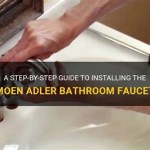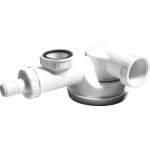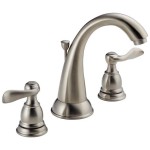Kohler Bathroom Sink Drain Stopper Replacement Parts List: A Comprehensive Guide
Replacing a Kohler bathroom sink drain stopper can appear daunting, but with the correct information and replacement parts, it becomes a manageable DIY project. This article provides a comprehensive list of Kohler bathroom sink drain stopper replacement parts, along with details about their function and compatibility. Understanding these components allows for accurate identification and procurement of the necessary parts to restore the drain's functionality.
Kohler, a well-known brand in plumbing fixtures, offers various drain stopper designs. These designs can differ based on the sink model and the year of manufacture. Before attempting any repairs, it is crucial to identify the specific model of the sink drain assembly. This information is often found in the original product documentation, on the Kohler website, or by contacting Kohler customer service with the sink's model number. Knowing the model number will ensure the correct replacement parts are ordered.
The subsequent sections focus on common Kohler bathroom sink drain stopper types and their constituent replacement parts. This is not an exhaustive list due to the variety of Kohler models, but it covers the most frequently encountered parts and their associated problems.
Identifying Common Kohler Drain Stopper Types
Kohler bathroom sinks utilize primarily three types of drain stoppers: pop-up stoppers, grid strainers, and lift-rod stoppers. Each type employs a different mechanism for controlling the flow of water into the drain. Understanding these mechanisms is paramount for correctly identifying and replacing faulty parts.
Pop-up Stoppers: Pop-up stoppers are activated by a lever located either behind the faucet or on the sink. When the lever is pushed or pulled, a connecting rod raises or lowers the stopper, opening or closing the drain. These stoppers are popular due to their ease of use and relatively concealed design.
Grid Strainers: Grid strainers are simpler designs that consist of a stationary, slotted grate positioned over the drain opening. They allow water to flow freely while preventing larger debris from entering the drainpipe. These strainers do not completely stop the flow of water, but they can be paired with a separate rubber stopper.
Lift-Rod Stoppers: Lift-rod stoppers are among the older and more prevalent designs. They feature a vertical rod extending from the stopper, which is connected to a horizontal rod beneath the sink. Lifting or lowering the rod raises or lowers the stopper, controlling the water flow. This system is generally reliable but can be subject to wear and tear over time.
The specific type of stopper dictates the necessary replacement parts. For instance, a pop-up stopper requires a pop-up assembly, while a grid strainer usually only necessitates a new strainer if damaged.
Common Kohler Bathroom Sink Drain Stopper Replacement Parts
Several components comprise a Kohler bathroom sink drain stopper assembly. Identifying each part and its function is critical for successful repairs. Following is a detailed list of the most common replacement parts:
Stopper Body: The stopper body is the primary component that physically blocks the drain. It is typically made of brass, stainless steel, or plastic. The stopper body can become worn, corroded, or damaged, preventing a tight seal. Replacement stoppers are available in various finishes to match existing bathroom fixtures.
Stopper Flange: The stopper flange is the visible portion of the stopper that rests on the sink’s surface around the drain opening. It is usually chrome, nickel, or another decorative finish. Over time, the flange can tarnish, corrode, or become scratched. Replacing the flange can improve the appearance of the sink drain.
Pivot Rod: The pivot rod connects the pop-up lever or lift rod to the stopper. It passes through a hole in the tailpiece and engages with a slot or socket on the stopper body. The pivot rod allows the lever to raise and lower the stopper. This rod is prone to bending, breaking, or corroding, especially at the pivot point.
Pop-Up Lever (or Lift Rod): The pop-up lever (for pop-up stoppers) or lift rod (for lift-rod stoppers) is the mechanism that activates the stopper. It is typically located behind the faucet or on the sink deck. The lever or rod can become loose, broken, or disconnected from the pivot rod, preventing the stopper from functioning correctly.
Tailpiece: The tailpiece is the vertical pipe extending from the bottom of the drain flange. It connects the drain assembly to the P-trap. The tailpiece can corrode or develop leaks over time. Replacing the tailpiece may be necessary if it is significantly damaged.
P-Trap: While not directly part of the stopper, the P-trap is an essential component of the drain system. It is a U-shaped pipe that traps water, preventing sewer gases from entering the bathroom. A damaged or leaking P-trap can cause odors and water damage. Replacing the P-trap may be required if it is cracked or corroded.
Mounting Nut: This nut secures the drain flange to the sink. It's usually made of metal and requires tightening to create a watertight seal. Over tightening can damage the sink while under tightening can result in leakage. Correct torque is essential.
Washers and Gaskets: Washers and gaskets are used to create a watertight seal between the drain flange, tailpiece, and other components. These are typically made of rubber or silicone. Over time, washers and gaskets can dry out, crack, or deteriorate, leading to leaks. Replacing these seals is often necessary when repairing a drain stopper.
Spring Clip: Some pop-up drain designs utilize a spring clip or similar retaining mechanism to hold the pivot rod in place. A broken or missing spring clip can cause the pivot rod to dislodge, preventing the stopper from functioning correctly.
Adjustment Screw: The adjustment screw fine-tunes the height of the stopper in pop-up drain systems. This allows you to adjust the seal created by the stopper, controlling how quickly or slowly the sink drains. A stripped or corroded adjustment screw can hinder the stopper's ability to seal tightly.
Complete Drain Assemblies: In some cases, it may be more practical to replace the entire drain assembly rather than individual parts. This is especially true if multiple components are worn or damaged. Complete drain assemblies typically include the drain flange, stopper, pivot rod, tailpiece, and other necessary hardware.
Troubleshooting Common Drain Stopper Problems
Identifying the specific problem with the Kohler bathroom sink drain stopper is the key to selecting the correct replacement parts. Common issues include:
Stopper Not Sealing Properly: If the stopper does not create a tight seal, water will slowly drain from the sink. This can be caused by a worn or damaged stopper body, a misaligned pivot rod, or debris obstructing the stopper.
Stopper Jamming or Sticking: A stopper that jams or sticks may be caused by corrosion, mineral buildup, or a bent pivot rod. Cleaning the stopper and surrounding components may resolve the issue. Otherwise, inspect the pivot rod for damage and replace as needed.
Pop-Up Lever Not Functioning: If the pop-up lever does not raise or lower the stopper, it is likely that the pivot rod is disconnected or broken, or the lever mechanism is damaged. Inspect the connection between the lever and pivot rod and replace any broken parts.
Leaks Around the Drain Flange: Leaks around the drain flange are typically caused by a worn or damaged washer or gasket. Replacing the washer or gasket will usually resolve the leak. Ensure the mounting nut is properly tightened without over-tightening.
Slow Draining: Slow draining can be a result of a partial blockage in the drainpipe, debris caught in the stopper assembly, or a malfunctioning stopper mechanism. Cleaning the drainpipe and stopper assembly may improve drainage. A partially closed stopper, due to a faulty connecting rod, can also slow drainage.
Corrosion: Depending on the water quality and the materials of the components, corrosion can build up and affect the proper function of the drain. Cleaning the components with appropriate cleaning solution or replacing severely corroded parts can help.
When troubleshooting, it is advisable to have a variety of basic plumbing tools on hand, including adjustable wrenches, pliers, screwdrivers, and a basin wrench. Proper tools will make the repair process easier and reduce the risk of damaging the sink or drain components.
Selecting the appropriate replacement parts requires careful attention to detail. Refer to the Kohler product documentation or consult with a plumbing professional to ensure compatibility. Using incompatible parts can lead to further damage and prevent the drain stopper from functioning correctly.
While this article offers a comprehensive guide, it is important to consider the complexity of plumbing repairs. If unsure about any aspect of the repair process, consulting with a qualified plumber is always recommended. Professionals possess the knowledge and experience to diagnose and resolve plumbing problems safely and effectively.

Kohler Standard Er Drain With Overflow In Polished Chrome K Rh1274364 Cp
Adjusting Pop Up Drains Sinks Kohler Assist

Kohler Standard Er Drain With Overflow In Matte Black K Rh1274364 Bl

Kohler Rh1464524 Cp Er Drain With Overflow In Polished Chrome

Getting Spring Clip To Stay On

How To Remove Bathroom Sink Drain Collar

Bathroom Sink Pop Up Stopper Parts Diagram

Repair Part Kohler Bath Stopper Oem Replacement For Parts 29011 30289 41077

Sink Drains Stoppers At Com
Kohler 1 4 In D Brushed Nickel Plastic Pop Up Drain
Related Posts







